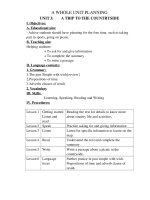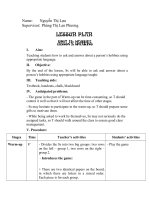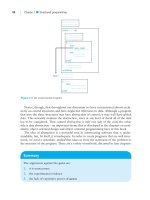Softwaretesting 13 eng
Bạn đang xem bản rút gọn của tài liệu. Xem và tải ngay bản đầy đủ của tài liệu tại đây (701.28 KB, 61 trang )
ソフトウェアテスト
[13] バグ予測とテスト計予測とテスト計とテスト計テスト計
画
Software Testing
[13] Bug Prediction and Test Plan
あまん ひろひさ ひろひさ
阿萬 裕久 裕久( AMAN
Hirohisa )
(C) 2007-2022 Hirohisa AMAN
1
Fault-Prone module analysis
Bug is often called fault in software en
gineering
A programmer's error introduces a fault i
nto the program. As a result, faults, failu failu
res, failu defects occur during program execut
ion.
Find features of modules likely to be f
aulted by metrics (Fault-Prone)
(C) 2016-2022 Hirohisa AMAN
2
Sig nificance of Fault-Prone
module analysis
Activities required for software quality
assurance:
Test
Review
Help plan these activities:
Identify where the fault is likely to be
*Intuitively, The idea is "Where is the intersection where accidents
are likely to occur?"
(C) 2016-2022 Hirohisa AMAN
3
Focus on the distribution of fault
s (bug s)
Faults (bug s) are made incorrectly by hu
mans
Even if you focus only on each bug, the ca
use is different. Therefore, it is difficult to a
nalyze it by itself.
A statistical approach is important to captu
re overall trends
Let's look at how faults (bugs) have be
en distributed so far.
(C) 2016-2022 Hirohisa AMAN
4
(Reappears)
Pareto principle
About 80% of bugs are present in about 2 of bug s are present in about 2
0% of bugs are present in about 2 of modules
concentrated in fewer parts
spread
uniformly
(C) 2016-2022 Hirohisa AMAN
5
Launch RStudio
Let's analyze the data using RStudio
Download Rscript13.R and data13.
csv from Teams
Open Rscript13.R in RStudio
(C) 2016-2022 Hirohisa AMAN
6
Use the same metric data
as last time
First, use the same NASA-published d
ata as last time
Data file name data13.csv
Load this content as a dataframe named
data
data = read.csv( file.choose( ))
(C) 2016-2022 Hirohisa AMAN
7
Start with a simple analysis
The module set is divided into two typ
es, “non bug g y” and "bug g y”,
See the difference in cyclomatic numbers
Find the threshold for bug prediction (of c
yclomatic number)
Non buggy
comparison
8
3
11
5
Buggy
14
8
20
12
(C) 2016-2022 Hirohisa AMAN
8
Column name
Box plot plot
Column name
DataFrame
boxplot(CC~BUG, data=data)
Although it is rough, you
can see the difference in
distribution
Vertical axis: cyclomatic number
Horizontal axis: presence or
absence of bugs
(0 = none,1 = yes)
(C) 2016-2022 Hirohisa AMAN
9
Compare by summary statistics
Separate the cyclomatic numbers with non bug g
y and bug g y and check with the summary functi
on
cc0 = data$CC[data$BUG==0]
cc1 = data$CC[data$BUG==1]
summary(cc0) summary(cc1)
Min. 1st Qu.
Max.
1.000
1.000
96.000
Median
2.000
Mean 3rd Qu.
4.705
5.000
Min. 1st Qu. Median
Mean 3rd Qu.
(C) 2016-2022 Hirohisa AMAN
10
Max.
Consider Metric Thresholds
Looking at data, the cyclomatic number se
ems to be related to the presence or absenc
e of bug s
A larg er cyclomatic number is more suspi
cious
Therefore , if it is larg er than a certain valu
Yes that there
Nois a bug .
e, failu let's predict
CC >
Buggy
Non buggy
(C) 2016-2022 Hirohisa AMAN
11
Split dataset
Consider a simple predictive model
Training data is needed to build this pred
ictive model
Furthermore, to evaluate the capabilities
of the predictive model, test data is also
required
So let's split the data into two and pr
epare them.
(C) 2016-2022 Hirohisa AMAN
12
Random Distribution
First shuffle row number 1 ~ nrow (dat ~ nrow (dat nrow (dat
a): get a list of shuffled row numbers w g et a list of shuffled row numbers w
ith the following function sample: get a list of shuffled row numbers w
set.seed(1234)
idx = sample(nrow(data))
(C) 2016-2022 Hirohisa AMAN
13
Split data after shuffling
training data (d.train): first 300
d.train = data[idx[1:300], ]
test data (d.test): remaining 205
d.test = data[idx[301:nrow(data)], ]
(C) 2016-2022 Hirohisa AMAN
14
(Ex plot)When the threshold of the cyc
lomatic number is set to 1 ~ nrow (dat0(1 ~ nrow (dat/6)
As a simple example, If the cyclomatic
number(CC)ex plotceeds 1 ~ nrow (dat0, let's predict t
hat there is a bug
Check the training data for bugs in thi
s module
d.train$BUG[d.train$CC>10]
[1] 0 0 0 1 1 0 0 0 0 0 0 0 1 1 0 1 0 0 0 0 0 1 0 0 1 1 0 0 0 0 0 0 0 1 0 0 0
0 1 0 0
(C) 2016-2022 Hirohisa AMAN
15
(Ex plot)When the threshold of the cyc
lomatic number is set to 1 ~ nrow (dat0(2/6)
The result of "predicting that there is a
bug " as the result
result = d.train$BUG[d.train$CC>10]
[1] 0 0 0 1 1 0 0 0 0 0 0 0 1 1 0 1 0 0 0 0 0 1 0 0 1 1 0 0 0 0 0 0 0 1 0 0 0
0 1 0 0
length(result)
sum(result)
Number of
correct answers
in the prediction
Predicted number
[1] 41
[1] 10
(C) 2016-2022 Hirohisa AMAN
16
(Ex plot)When the threshold of the cyc
lomatic number is set to 1 ~ nrow (dat0(3/6)
If you org anize the results
length(result)
sum(result)
Number of
correct answers
in the prediction
Predicted number
[1] 41
[1] 10
Results of predictions
using training data
Predic Buggy
tion
Non Buggy
Actual
Buggy
Non Buggy
total
10
31
41
total
(C) 2016-2022 Hirohisa AMAN
17
(Ex plot)When the threshold of the cyc
lomatic number is set to 1 ~ nrow (dat0(4/6)
The actual number of bugs was
sum(d.train$BUG)
Number of actual bugs
[1] 30
Results of predictions
using training data
Predic Buggy
tion
Non Buggy
total
Actual
Buggy
Non Buggy
total
10
31
41
20
30
(C) 2016-2022 Hirohisa AMAN
18
Recall and Precision
Actually
bug g y
(correct
answer set)
Predictio
n
success
Bug g y
and
predicted
Recall
Actually bug g y
(correct answer
set)
Predictio
n
success
View by
percentag e
Precision
Predictio
n
success
Bug g y and
predicted
(C) 2016-2022 Hirohisa AMAN
19
(Ex plot)When the threshold of the cyc
lomatic number is set to 1 ~ nrow (dat0(5/6)
Results of predictions
using training data
Predic Buggy
tion
Non Buggy
Actual
Buggy
Non Buggy
10
total
41
30
total
10
𝑅𝑒𝑐𝑎𝑙𝑙=
≅ 0.333
30
10
P 𝑟𝑒𝑐𝑖𝑠𝑖𝑜𝑛=
≅ 0.244
41
(C) 2016-2022 Hirohisa AMAN
20









